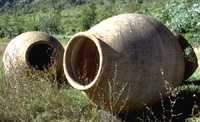Provence-Beyond (Beyond the French Riviera) ®
Also: [ Pottery | Potters | Faïence Pottery | Pottery Calendar | Santons | Glass Blowing ]
Photos:
01. Jarres (29 k)
02. Blue, olive pattern plate (33 k)
03. Green, olive pattern plate (32 k)
04. Large pots and jarres (38 k)
05. Large amphore style pitcher (33 k)
06. Blue cups and serving tray (28 k)
07. Blue swirl line pitchers and plate (36 k)
08. Blue swirl line plate (36 k)
09. Yellow sun plate (26 k)
10. Green edged plate, farm center (30 k)
11. Green-yellow plate, farm center (31 k)
12. Blue-yellow bowls (22 k)
13. Blue-yellow jars (25 k)
14. Olive pattern plate, mirror (35 k)
15. Eggs (37 k)
16. Blue tea set, bowls and pot (26 k)
 Pottery has been a feature of the Beyond region, across Provence and the Côte d'Azur, for thousands of years. Under Sophia, in the Geology section, tells about the clay used here since pre-Roman times.
Pottery has been a feature of the Beyond region, across Provence and the Côte d'Azur, for thousands of years. Under Sophia, in the Geology section, tells about the clay used here since pre-Roman times.
In the 17th century, sepecial techniques for enamelling and firing came to Provence from the East, via Italy. One of the most famous styles, Faïence from Mousiters-Sainte-Marie, evolved into its own colors, patterns and decorations.
Jarres
 Large earthenware jarres were made to store and transport olive oil and other local products. The first Jarres de Biot, were made on the Brague plaine near Antibes, and later at Biot, following the return of the Crusaders. In the 18th century, there were over 30 places around Biot still making the jarres.
Large earthenware jarres were made to store and transport olive oil and other local products. The first Jarres de Biot, were made on the Brague plaine near Antibes, and later at Biot, following the return of the Crusaders. In the 18th century, there were over 30 places around Biot still making the jarres.
The jarres are made by mixing the grey clay (terre grise) from Vaugrenier and the red clay (terre rouge) from Clausonnes. The jarres are made by hand, without mould or wheel. First the round bottom is layed out. Then circled ropes of clay are stacked on top, sized to give the form of the jarre. When the form is complete, the clay is smoothed by hand, inside and ou, and the jarre is dried before going into the kiln at about 1000 °C. The final step is the varnish.